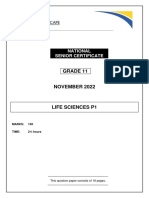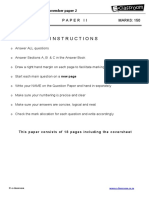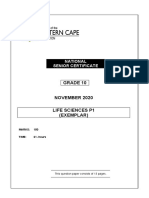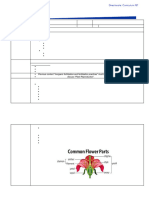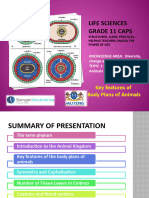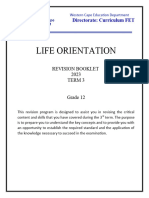LIFE SCIENCES P2 GR11 QP NOV 2023 - English
Uploaded by
sinazoomtyideLIFE SCIENCES P2 GR11 QP NOV 2023 - English
Uploaded by
sinazoomtyideNATIONAL
SENIOR CERTIFICATE
GRADE 11
NOVEMBER 2023
LIFE SCIENCES P2
MARKS: 150
TIME: 2½ hours
This question paper consists of 15 pages.
2 LIFE SCIENCES P2 (EC/NOVEMBER 2023)
INSTRUCTIONS AND INFORMATION
Read the following instructions carefully before answering the questions.
1. Answer ALL the questions.
2. Write ALL the answers in the ANSWER BOOK provided.
3. Start EACH question on a NEW page.
4. Number the answers correctly according to the numbering system used in this
question paper.
5. Present your answers according to the instructions of each question.
6. Do ALL drawings in pencil and label them in blue or black ink.
7. Draw diagrams, tables or flow charts ONLY when asked to do so.
8. The diagrams in this question paper are NOT necessarily drawn to scale.
9. Do NOT use graph paper.
10. You may use a non-programmable calculator, protractor and a compass, where
necessary.
11. Round off all calculations to two decimal spaces.
12. Write neatly and legibly.
Copyright reserved Please turn over
(EC/NOVEMBER 2023) LIFE SCIENCES P2 3
SECTION A
QUESTION 1
1.1 Various options are provided as possible answers to the following questions.
Choose the answer and write only the letter (A–D) next to the question numbers
(1.1.1 to 1.1.9) in the ANSWER BOOK, for example 1.1.10 D.
1.1.1 Vaccines work because …
A they contain antibodies that destroy disease causing organisms.
B they destroy disease causing organisms by dissolving their cell
membranes.
C they trigger the body to produce antibodies to protect the body
against disease causing organisms.
D it contains drugs that destroy disease causing organisms.
1.1.2 Which of the following phyla is diploblastic?
A Porifera
B Chordata
C Annelida
D Cnideria
1.1.3 Which characteristic best describes the organisms in the diagram below?
A Triploblastic
B Radially symmetrical
C Shows cephalization
D Has a notochord
Copyright reserved Please turn over
4 LIFE SCIENCES P2 (EC/NOVEMBER 2023)
1.1.4 Advantages of a coelom:
(i) Independent movement and digestive system
(ii) Needs a blood system
(iii) Coelomic fluid acts as a hydrostatic skeleton
(iv) More space for complex organs and organ systems
Which of the above statements represent advantages of having a true
coelom?
A (i), (ii), (iv)
B (i), (iii), (iv)
C (ii), (iii), (iv)
D (i), (ii), (iii), (iv)
1.1.5 Which combination listed below represents wind-pollinated plants?
A Large bright petals and lots of nectar
B Brightly coloured petals and small, light pollen
C Large anthers and lots of nectar
D Small petals and large, feathery stigmas
1.1.6 The shape of the bacteria below can be classified as …
A coccus.
B bacillus.
C vibrio.
D spirillum.
1.1.7 Which statement below best describes emigration?
A Increase in population size
B Migration of animals.
C Permanent movement of organisms out of a habitat.
D Movement of people from city to city.
Copyright reserved Please turn over
(EC/NOVEMBER 2023) LIFE SCIENCES P2 5
1.1.8 Two species of paramecium were found in a pond. The graph below
shows the population growth of the two species (A and B) that feed on
the same bacteria.
200
A
Population density
150
(by volume)
100
50
B
0 2 4 6 8 10 12 14 16 18 20
Time in Days
The graph above shows an example of …
A parasitism.
B resource partitioning.
C competitive exclusion.
D predator-prey relation.
1.1.9 Study the graph below.
TOTAL SURVIVORS
AGE
The graph above best represents the survivor curve of …
A humans.
B frogs.
C birds.
D lions.
(9 x 2) (18)
Copyright reserved Please turn over
6 LIFE SCIENCES P2 (EC/NOVEMBER 2023)
1.2 Give the correct biological term for each of the following descriptions. Write
only the term next to the question numbers (1.2.1 to 1.2.8) in the ANSWER
BOOK.
1.2.1 An organism that captures and kills another organism for food
1.2.2 A direct method whereby all individuals in a human population are
counted
1.2.3 A process in biotechnology that is used to convert sugar into alcohol and
carbon dioxide
1.2.4 An organism without a true nucleus
1.2.5 A diagram showing the evolutionary relationship between organisms
1.2.6 A type of gut that is found in Annelids
1.2.7 A disease-causing organism
1.2.8 The access, by all people at all times, to adequate, safe and nutritious
food (8 x 1) (8)
1.3 Indicate whether each of the statements in COLUMN Ι, applies to A ONLY, B
ONLY, BOTH A and B, or NONE of the items in COLUMN ΙΙ. Write A only, B
only, both A and B, or none next to the question numbers (1.3.1 to 1.3.3) in the
ANSWER BOOK.
COLUMN Ι COLUMN ΙΙ
1.3.1 Tick on a dog A: Symbiosis
B: Parasitism
1.3.2 Decreases food security A: Droughts
B: GM foods
1.3.3 Characteristic of a population A: Same species
B: Live in the same habitat
(3 x 2) (6)
Copyright reserved Please turn over
(EC/NOVEMBER 2023) LIFE SCIENCES P2 7
1.4 Study the population growth curve below.
ENVIRONMENTAL RESISTANCE
E
D
Population size
C
Time
1.4.1 Name the type of growth form shown in the graph above. (1)
1.4.2 Provide the following labels:
(a) Stage D (1)
(b) Line E (1)
1.4.3 Explain why the growth at stage A is slow. (2)
1.4.4 Name TWO factors that could form part of environmental resistance. (2)
1.4.5 Name TWO inherent factors that would cause an increase in population
size. (2)
Copyright reserved Please turn over
8 LIFE SCIENCES P2 (EC/NOVEMBER 2023)
1.5 Study the diagrams below.
Plant A Plant B
1.5 1.5.1 Name the plant division to which plant A belongs. (1)
1.5.2 Give TWO characteristics found in both plant A and B. (2)
1.5.3 Explain why plant A is less reliant on water than plant B. (3)
1.5.4 Provide labels for the following:
(a) 1 (1)
(b) 2 (1)
1.5.5 Why is the plant in generation B NOT considered a thallus plant? (1)
TOTAL SECTION A: 50
Copyright reserved Please turn over
(EC/NOVEMBER 2023) LIFE SCIENCES P2 9
SECTION B
QUESTION 2
2.1 Study the diagrams below.
Mushrooms
Bread mould
A
Yeast
2.1.1 To which kingdom do all the above organisms belong? (1)
2.1.2 Provide labels for A and B. (2)
2.1.3 Name the thread-like filaments that make up the body of a bread mould. (1)
2.1.4 Name TWO conditions needed for bread mould to grow. (2)
2.1.5 Name TWO products that yeast is used for. (2)
2.1.6 Explain ONE way in which organisms in this kingdom play an important
role in the environment. (2)
Copyright reserved Please turn over
10 LIFE SCIENCES P2 (EC/NOVEMBER 2023)
2.2 An investigation was done to determine if the amount of petals affects the
fertilisation of the ovule.
When flowers are self pollinated, the pollen tube grows only a little way into the
stigma and style and fertilisation does not occur. When cross pollination occurs
by pollinators then the pollen tubes grow all the way down and fertilisation of the
ovule can occur.
The investigation was conducted as follows:
• 30 flowers were used. 10 flowers with 100% petals, 10 flowers with
50% of the petals removed and 10 flowers with 0% petals
• flowers were placed in an area with pollinators for 2 days
• after 2 days the flowers were prevented from further pollination
• after 7 days the amount of pollination and fertilisation in each flower
was recorded
The diagrams below show the appearance of the flowers used.
A
B
C
100% of petals left 50% of petals left 0% petals left on
on on
The results are shown in the table below.
NUMBER
Flower with Flower with Flower with no
100% of 50% of petals petals
petals
Pollen on stigma 158 149 25
Pollen tubes in the style 86 82 8
Ovules fertilised 38 40 4
2.2.1 For this investigation give the:
(a) Independent variable (1)
(b) Dependant variable (1)
2.2.2 Supply labels for:
(a) Structure A (1)
(b) Whorl B (1)
(c) Structure C (1)
Copyright reserved Please turn over
(EC/NOVEMBER 2023) LIFE SCIENCES P2 11
2.2.3 Explain why there was more pollen on the flowers with petals. (2)
2.2.4 Explain why there are more pollen tubes present in the style of all flowers
than the number of ovules fertilised. (2)
2.2.5 Give TWO ways the validity of this experiment could be improved. (2)
2.2.6 Write a conclusion for this experiment. (2)
2.2.7 State TWO ways in which angiosperms are better adapted to terrestrial
life than bryophytes. (2)
2.2.8 Name the plant division to which angiosperms belong. (1)
2.2.9 Give TWO advantages of sexual reproduction. (2)
2.3 Read the extract below.
Malaria is a deadly disease caused by Plasmodium sp. and transmitted through
the female Anopheles mosquito. In 2020, 627 000 people around the world died
from malaria.
DDT is a pesticide used to control mosquito populations in malaria areas. In the
early 1990s there was a worldwide ban on the use of DDT. DDT is non-
biodegradable. It affects animals at the top of the food chain. It caused the decline
of many birds of prey as it made the shells of their eggs very thin.
The number of deaths due to malaria rose from 19 in 1991 to 450 in 2000. The
South African government decided to lift the ban and started using DDT again. By
2020 there were only 38 deaths due to malaria.
2.3.1 Name the kingdom to which the malaria parasite belongs. (1)
2.3.2 Give evidence from the passage that the use of DDT has a negative effect
on the environment. (1)
2.3.3 Explain the economic impact to a country if there is a high percentage of
people suffering from malaria. (2)
2.3.4 Explain how the Anopheles mosquito transmits malaria. (2)
2.3.5 Give TWO precautions besides killing mosquitoes that people can take to
prevent getting malaria. (2)
2.3.6 Name the TWO different human body cells that the plasmodium parasite
attacks. (2)
Copyright reserved Please turn over
12 LIFE SCIENCES P2 (EC/NOVEMBER 2023)
2.4 The diagrams below show animals that belong to two different phyla.
Organism X Organism Y
2.4.1 Name the phyla to which Organism X belongs. (1)
2.4.2 For each of the statements below, write only X or Y.
(a) Organism that has a through gut (1)
(b) Organism that has no organs (1)
(c) Organism that is sedentary (1)
2.4.3 What type of symmetry is shown by Organism Y? (1)
2.4.4 Describe how the body plan of Organism Y is suited to an organism that
actively moves from one environment to another. (3)
2.4.5 Draw a simple labelled diagram of a cross section through the body wall
to show the tissue layers found in Organism Y. (4)
[50]
Copyright reserved Please turn over
(EC/NOVEMBER 2023) LIFE SCIENCES P2 13
QUESTION 3
3.1 The table below shows the average atmospheric carbon dioxide level over 60
years.
The table showing the contribution of different sources of electricity in 2021 and
the planned contribution of different sources to electricity in South Africa in 2030.
Contribution to electricity Planned contribution to
Source consumption in 2021 electricity consumption in 2030
(%) (%)
Coal 84,4 46
Gas 0,8 16
Wind 3,4 15
Solar 2 11
Hydro 2,8 10
Nuclear 5,3 2
Other 1,4 0
3.1.1 Which source provided the most electricity in South Africa in 2021? (1)
3.1.2 Explain how coal generated electricity increases global warming. (4)
3.1.3 Explain why Eskom wants to increase the amount of wind and solar
generated electricity. (2)
3.1.4 Draw a pie chart showing the planned sources of electricity for 2030. (7)
3.1.5 What is the difference between the percentage of gas generated
electricity used in 2021 and 2030? (2)
Copyright reserved Please turn over
14 LIFE SCIENCES P2 (EC/NOVEMBER 2023)
3.2 Dandelions are weeds that often grow on schools sports fields. The groundsman
at a school is responsible for making sure that the soccer field is well maintained
and has no weeds.
He wanted to calculate the number of dandelion weeds on their soccer field.
• The size of the soccer field is 2 500 m2.
• He used 1 m x 1 m (1 m2) quadrats and took 15 samples across the field.
• The number of dandelions in each sample were recorded in the table below.
Sample Number of
number dandelion plants
1 22
2 3
3 7
4 4
5 15
6 0
7 3
8 0
9 12
10 3
11 0
12 14 Dandelion plant
13 4
14 7
15 2
3.2.1 What is this method of estimating population size called? (1)
3.2.2 The grounds man did not know where to place the quadrats on the field.
Explain how he should go about determining where to place them. (2)
3.2.3 Calculate the total number of dandelions on the field. (5)
3.2.4 Why were fifteen samples taken instead of five? (1)
3.2.5 Give ONE reason why the groundsman would want to know the total
number of weeds on the field. (1)
3.3 Tabulate TWO differences between a developed country and a developing
country that affects their population growth curves. (5)
Copyright reserved Please turn over
(EC/NOVEMBER 2023) LIFE SCIENCES P2 15
3.4 Read the extract below.
Acid mine drainage has a negative effect on the environment. Mines often use
lime to neutralise the acidic water before it is pumped into rivers and streams.
But lime needs to be mined especially for this purpose.
It contaminates soil so that the plants do not get enough of the required nutrients
to grow, it contaminates drinking water, disrupts the growth and reproduction of
aquatic animals and corrodes buildings and structures like bridges.
New research shows that slag, a very alkaline waste product made from mining,
is effective in neutralising the acidic water.
3.4.1 Describe how acid mine drainage forms. (3)
3.4.2 Give TWO negative effects of acid mine drainage on the environment
mentioned in the extract. (2)
3.4.3 Explain why it is economically better to use slag to neutralise the acidic
water than lime. (4)
3.4.4 Give ONE other way mining affects the quality of water. (1)
3.5 Alien plants such the water hyacinth (Eichhomia sp.) have become invasive in
South Africa, blocking water ways and reducing water quality.
3.5.1 Differentiate between alien plants and indigenous plants. (2)
3.5.2 Why do alien plants become invasive in an ecosystem? (1)
3.5.3 State TWO ways that the government could use to control alien plants. (2)
3.5.4 Describe how alien plants may affect aquatic animals by reducing water
quality. (4)
[50]
TOTAL SECTION B: 100
GRAND TOTAL: 150
Copyright reserved Please turn over
You might also like
- Kzn Lfsc Term 1 and 2 Grade 11 Jit Teacher Doc 2025No ratings yetKzn Lfsc Term 1 and 2 Grade 11 Jit Teacher Doc 202531 pages
- Agricultural Sciences Revision Material T3 GR 11100% (2)Agricultural Sciences Revision Material T3 GR 1139 pages
- Life Sciences Grade 10 Revision Answers Term 2 - 2023No ratings yetLife Sciences Grade 10 Revision Answers Term 2 - 20234 pages
- Prometric Mcqs For General Practitioner GP Doctor Mcqs Exam Questions100% (1)Prometric Mcqs For General Practitioner GP Doctor Mcqs Exam Questions28 pages
- Life Sciences p1 Nov 2022 Gr11 Eastern CapeNo ratings yetLife Sciences p1 Nov 2022 Gr11 Eastern Cape16 pages
- Grade 10 Term 2 Support and Transport Systems in Plants 5100% (1)Grade 10 Term 2 Support and Transport Systems in Plants 522 pages
- Life Sciences p2 QP Memo Gr11 Nov2020eng D 2No ratings yetLife Sciences p2 QP Memo Gr11 Nov2020eng D 232 pages
- Life Sciences P2 Grade 11 Exemplar 2013 Eng100% (2)Life Sciences P2 Grade 11 Exemplar 2013 Eng14 pages
- LFSC 2020 Gr10 Question Paper Nov Dec Mopani East District Test 1 of 2No ratings yetLFSC 2020 Gr10 Question Paper Nov Dec Mopani East District Test 1 of 210 pages
- Grade 11 - Life Science - November Paper 2-2No ratings yetGrade 11 - Life Science - November Paper 2-217 pages
- KZN Life Sciences Grade 11 June 2024 QP and MemoNo ratings yetKZN Life Sciences Grade 11 June 2024 QP and Memo23 pages
- Life Sciences p2 QP Gr10 Nov2017 - English - EcNo ratings yetLife Sciences p2 QP Gr10 Nov2017 - English - Ec16 pages
- Gr.10 Answers Remote Learning Workbook Term 2No ratings yetGr.10 Answers Remote Learning Workbook Term 218 pages
- Agricultural Sciences P2 Grade 10 2017 MEMO EnglNo ratings yetAgricultural Sciences P2 Grade 10 2017 MEMO Engl9 pages
- Physical Sciences Grade 11 Solution For Homework Activities Term 1-4No ratings yetPhysical Sciences Grade 11 Solution For Homework Activities Term 1-475 pages
- KZN LFSC Grade 11 Step Ahead Learner Support Document2023No ratings yetKZN LFSC Grade 11 Step Ahead Learner Support Document202349 pages
- KZN Step Ahead Life Sciences Grade 11 SolutionsNo ratings yetKZN Step Ahead Life Sciences Grade 11 Solutions67 pages
- Life Science Grade 10: November Exam 2022 Paper 1 - QP ONLY100% (1)Life Science Grade 10: November Exam 2022 Paper 1 - QP ONLY14 pages
- Life Sciences Informal Test 4 (Genetics) Grade 12 - 12 April 2024 - Mg_065527No ratings yetLife Sciences Informal Test 4 (Genetics) Grade 12 - 12 April 2024 - Mg_0655277 pages
- Limpopo Life Sciences Grade 11 June Exam 2022 QP and MemoNo ratings yetLimpopo Life Sciences Grade 11 June Exam 2022 QP and Memo28 pages
- Grade 11 Life Sciences Revision Material Term 2 2023No ratings yetGrade 11 Life Sciences Revision Material Term 2 202325 pages
- KZN LFSC TERM 1 and 2 Grade 11 JIT LEARNER DOC 2025No ratings yetKZN LFSC TERM 1 and 2 Grade 11 JIT LEARNER DOC 202543 pages
- life-sciences-grade-11-revision-memo-term-2-2024No ratings yetlife-sciences-grade-11-revision-memo-term-2-202412 pages
- KZN Life Sciences Grade 11 September 2023 QP and MemoNo ratings yetKZN Life Sciences Grade 11 September 2023 QP and Memo12 pages
- limpopo-province-lfsc-2025-grade-12-pacesetter-13-jan-2025No ratings yetlimpopo-province-lfsc-2025-grade-12-pacesetter-13-jan-202510 pages
- Limpopo Province LFSC Gr10 Pacesetter 2024No ratings yetLimpopo Province LFSC Gr10 Pacesetter 20246 pages
- Gr.10 LIFE SCIENCES Remote Learning Booklet Terms 1 - 4No ratings yetGr.10 LIFE SCIENCES Remote Learning Booklet Terms 1 - 4184 pages
- Grade 10 - Life Science - November Exam - Memo PDF Cell Nucleus Cell (Biology)No ratings yetGrade 10 - Life Science - November Exam - Memo PDF Cell Nucleus Cell (Biology)1 page
- Grade 11 - Life Science - November Paper 2-1No ratings yetGrade 11 - Life Science - November Paper 2-120 pages
- Mamelodi East Grade 11 Term 1 Control TestNo ratings yetMamelodi East Grade 11 Term 1 Control Test10 pages
- Gr9 NS (English) November 2021 Question PaperNo ratings yetGr9 NS (English) November 2021 Question Paper20 pages
- EC Life Sciences Grade 11 November 2023 P2 and MemoNo ratings yetEC Life Sciences Grade 11 November 2023 P2 and Memo26 pages
- Life Sciences p2 Gr11 QP Nov2017 English (Original)No ratings yetLife Sciences p2 Gr11 QP Nov2017 English (Original)15 pages
- LIFE SCIENCES P2 GR11 QP NOV2018 - EnglishNo ratings yetLIFE SCIENCES P2 GR11 QP NOV2018 - English16 pages
- LIFE SCIENCES P2 QP GR11 NOV2020 - EnglishNo ratings yetLIFE SCIENCES P2 QP GR11 NOV2020 - English17 pages
- LIFE SCIENCES P2 GR11 QP NOV 2022 - EnglishNo ratings yetLIFE SCIENCES P2 GR11 QP NOV 2022 - English18 pages
- 3. Final Public Health Nursing II ModuleNo ratings yet3. Final Public Health Nursing II Module200 pages
- Syllabus-Neuroscience 10 Neuroscience in 21st Century-2012FallNo ratings yetSyllabus-Neuroscience 10 Neuroscience in 21st Century-2012Fall4 pages
- Your Honor, We Would Like To Have This PRC ID Marked As Exhibit P-10No ratings yetYour Honor, We Would Like To Have This PRC ID Marked As Exhibit P-107 pages
- 0) LT PACE-5 - PAPER With Key - 23.07.2023 - 1290861 - 2023 - 07 - 24 - 11 - 37No ratings yet0) LT PACE-5 - PAPER With Key - 23.07.2023 - 1290861 - 2023 - 07 - 24 - 11 - 3724 pages
- Tumors of Musculoskeletal: Tutorial Ortopaedic SurgeryNo ratings yetTumors of Musculoskeletal: Tutorial Ortopaedic Surgery108 pages
- Role of Traditional and Complementary MedicineNo ratings yetRole of Traditional and Complementary Medicine16 pages
- _Img_ExamPaper_5db5c586-62cc-4168-9789-65e3047cfced20240701034246512 (2)No ratings yet_Img_ExamPaper_5db5c586-62cc-4168-9789-65e3047cfced20240701034246512 (2)16 pages
- What Is Osteoporosis?: Osteoposis Is A Disease ofNo ratings yetWhat Is Osteoporosis?: Osteoposis Is A Disease of48 pages
- Instant download What Every Patient Family Friend and Caregiver Needs to Know About Psychiatry 2nd Edition Richard W. Roukema pdf all chapter100% (5)Instant download What Every Patient Family Friend and Caregiver Needs to Know About Psychiatry 2nd Edition Richard W. Roukema pdf all chapter51 pages
- 1 Mapsss000710 r1 Aqt90 Flex Brochure en LowNo ratings yet1 Mapsss000710 r1 Aqt90 Flex Brochure en Low7 pages
- Full Download Canine and Feline Cytology: A Color Atlas and Interpretation Guide, 3e 3rd Edition Rose E. Raskin PDF100% (4)Full Download Canine and Feline Cytology: A Color Atlas and Interpretation Guide, 3e 3rd Edition Rose E. Raskin PDF64 pages
- Instant ebooks textbook Hands- On Liferay DXP: Learn Portlet Development and Customization Using OSGi Modules 1st Edition Apoorva Prakash download all chapters100% (1)Instant ebooks textbook Hands- On Liferay DXP: Learn Portlet Development and Customization Using OSGi Modules 1st Edition Apoorva Prakash download all chapters55 pages








